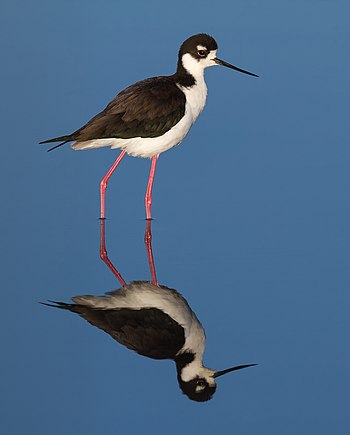Talk:Black-necked stilt
A fact from Black-necked stilt appeared on Wikipedia's Main Page in the Did you know column on 3 June 2006. The text of the entry was as follows:
|
| This article is rated B-class on Wikipedia's content assessment scale. It is of interest to the following WikiProjects: | |||||||||||
| |||||||||||
Range Info
[edit]This species exists as far east as the Florida-Georgia border, so I'm taking out some of the California bias here -- I get these as a yard bird in Chandler, Arizona (quite far from the originally stated eastern bounds of the Colorado River!), so the original range information was clearly a bit incomplete. If anyone has more concrete information on the abundance of this bird along the Gulf of Mexico, I think that would be merited here. Cheers! -- Miwa * talk * contribs ^_^ 15:37, 7 June 2006 (UTC)
They are definitely in southern Florida on the Atlantic Coast as well as the Gulf Coast. Bunnygod888 (talk) 11:54, 27 April 2008 (UTC)
Opinion/Bias/Fantasy in Article
[edit]It is impossible to prove that the black-necked stilt is "objectively": "slender"; "tuxedo-like". I think it is a somewhat meaty bird, unlike the sparrow or the hummingbird, more like an ostrich, a stork. It would be more accurate to describe this bird as appearing to be a cross between a flamingo and a penguin than to say the bird looks like it is wearing a tuxedo. No birds are wearing any tuxedos and that's crazy. You'll mislead everybody who reads the article, and they'll think the animal has clothes put on it. So, to recap, "slender" is a relative term expressing an opinion; "that bird is wearing a tuxedo" is absurd, to even suggest that in a normal mind any bird has formalwear on its body. Gabriel Arthur Petrie 13:54, 12 August 2006 (UTC)
What a mess - I've added the rest of the range (there is a world outside the US!), taken out bits about other forms, added references, tidied headings - it's still very parochial, but I'm reluctant to just axe all the US stuff. jimfbleak 11:10, 24 August 2006 (UTC)
- The entire taxonomy stuff is about early 1990s vintage. The stints need a cleanup altogether; the splits are long accepted by the IUCN. Anyone who wants to do it - get yourself the Charadriiformes "supertree" (it's in the references for free) and compare to the IUCN redlist. That should give anyone a pretty good idea where to draw the species boundaries. Dysmorodrepanis (talk) 12:55, 2 April 2008 (UTC)
i need help
[edit]I am doing a bird report on the Black-Necked Stilt. And, its kinda hard when I cant find any info on it. can you help me I need to know anything I can on Black-Necked Stilts. like characteristics or how the bird survives in winter or anything really, PLEASE help ME. I really need info on the Black-Necked Stilts. thank you, you can get to me by my E-MAIL. its janimallloverc@yahoo.com. —Preceding unsigned comment added by 69.145.121.161 (talk) 02:10, 1 May 2008 (UTC)
studying is the best help you'll ever get
[edit]So learn to do it.131.230.143.5 (talk) 20:58, 6 August 2009 (UTC)
Move discussion in progress
[edit]There is a move discussion in progress on Talk:Common Snipe which affects this page. Please participate on that page and not in this talk page section. Thank you. —RMCD bot 09:30, 4 May 2014 (UTC)
File:Black-necked Stilt (Himantopus mexicanus), Corte Madera.jpg to appear as POTD soon
[edit]Hello! This is a note to let the editors of this article know that File:Black-necked Stilt (Himantopus mexicanus), Corte Madera.jpg will be appearing as picture of the day on March 7, 2020. You can view and edit the POTD blurb at Template:POTD/2020-03-07. If this article needs any attention or maintenance, it would be preferable if that could be done before its appearance on the Main Page so Wikipedia doesn't look bad. :) Thanks! Cwmhiraeth (talk) 11:12, 27 February 2020 (UTC)
Seen here near Corte Madera, California, the black-necked stilt forages by probing and gleaning on mudflats, grassy marshes and lakesides, as well as in shallow waters near the shore; the diet consists mainly of insects and their larvae, crustaceans, other arthropods, mollusks, tadpoles and small fish. The species nests in colonies that may have several dozen pairs spread out loosely, with the birds defending an extensive perimeter around groups of nests, patrolling in cooperation with their neighbors.Photograph credit: Frank Schulenburg




